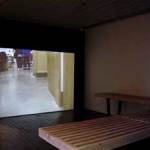In her catalog essay for Work Ethic, Helen Molesworth argues that one unifying principle among the incredible diverse field of post World War II art is a concern with the “problematic of artistic labor.” Indeed, post war artists seem delighted with the idea of relinquishing traditional artistic skills and reevaluating the status of labor in a culture where working for oneself or building your own furniture is very much a novelty. Artistic movements diverse as Fluxus, Pop, Conceptualism and Abstraction have all mimicked, taunted, and challenged traditional notions of work and its rapidly changing role in a late-capitalist culture.
In a new body of work at Green St. Gallery, Barbara Gallucci takes on the subject of labor and more specifically the one area most affected (or exploited) by late Capitalism – design. With the shifting of labor in America to overseas, where assembly line production can flourish cheaply, the role of the designer has affected the products and social life of Americans more pervasively than any other form of work.
In the five sculptures on view (plus one video projection) Gallucci tackles the affordability and accessibility of high Modern design by remaking Le Corbusier’s Le Petit Comfort Chair and Sofa, and George Nelson’s platform benches. Unable to afford the “original” furniture of these designers, which has acquired abhorrent value on secondary markets, Gallucci’s new mantra claims, “Do it Yourself.” With a 50% enlargement and the substitution of plywood for black leather, these replicas otherwise hold true to the original designs. Wonderfully fun and surprisingly comfortable these sculptures both ridicule and celebrate the great design of Le Corbusier and Nelson.
Gallucci’s transformation of these furniture designs speaks directly to the construction process, the labor involved in producing these oversized pieces. As modern design became more and more specific for its subsequent use, the less the labor of its construction could be seen. Gallucci’s denial of a standardized manufacture process leaves the labor to the artist, thus articulating Molesworth’s notion of "artistic labor."
What then is the value difference between a manufactured sofa or chair by Le Corbusier and a Barbara Gallucci replica? Especially considering that the plywood construction essentially prevents any real use of them. (Although, it must be noted that many people, including me, were climbing all over these things during the opening). While there may not be any real use-value to Gallucci’s sculptures, there does remain an abundance of ideological value; in that it situates a relationship to the standard manufacturing and production of high modern furniture. Crafted from Home Depot materials, an institution found almost anywhere that sells materials a large majority can afford, these sculptures embody the desire of the self-motivated individual who wants elegance and chic-ness at a blue collar price. Anyone with motive could make their own version of a Le Corbusier sofa; any size and material they want. Gallucci’s pointed critique then exclaims that perhaps the only access the majority of society has to high modern design is through fetishized museum display or through an institution like Home Depot.
Hence the value of Gallucci’s labor does not reside in creating a useful product or comfortable sofa. Her production is a sum of labor that embodies the historical limitations of Modernism and at the same time demonstrates the economic alternative by way of the “Do-It-Yourselfer.” Of course, the Do-It-Yourselfer privileges an institution like Home Depot, conforming to the standardized materials and sizes they choose to carry. As Home Depot marches towards a commercial monopoly of wholesale products, even do-it-yourselfers seem to be limited in their options. In this sense, Gallucci has made iconographic sculptures of Le Corbusier’s and Nelson’s furniture by pointing to the possible ways in which accessibility to these Modern accomplishments is possible. This possibility resides in the embrace of an institution like Home Depot. Is this better? Gallucci offers no clear answers but embodied in her labor is the outline of the predicament.
- Installation view with projection and Gallucci’s Nelson Benches.
- Gallucci lounging in her own Le Corbusier.
- Installation view of Do-It-Yourself at the Gallery at Green St.
Gallucci's "Do-It-Yourself" is on display at the Gallery @ Green St. from January 30 - March 6, 2004. Her photos were also seen at Gallery Kayafus in South End in February.
All images courtesy of the artist and the Gallery @ Green St.
Gallery @ Green St.
See Barbara in NEST
Barbara viva la France!
Foundation le Corbusier
Micah J. Malone has been with Big RED & Shiny since the beginning, and is an executive editor.







